1
This exhibit introduces you to the concept of lost built heritage. The buildings in our home towns and cities are not just made of wood and steel, bricks and mortar. They are full of memories and are the focal points of many of our small towns. Through examining our local "abandoned" buildings and spaces, you will learn how these places used to have considerable value to the community and how much we lose when the community forgets what these places once represented.2
W.K. Flesher's house on Flesher's Pondearly 1900's
Flesherton Pond, Flesherton, Ontario, Canada
 Credits:
Credits:South Grey Museum Archives
3
W.K. Flesher, County Warden and the gentleman the Village of Flesherton is named for, lived on the edge of Flesher's Pond. His small unassuming white clapboard home was a focal point of the community.4
W.K. Flesher's Home at Flesherton Pond7 December 2010
Flesherton Pond, Flesherton, Ontario, Canada
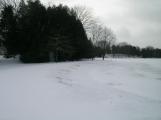 Credits:
Credits:South Grey Museum
5
W.K. Flesher's home is now gone - replaced by a pavillion and a swimming beach at the pond. People still swim and fish at the pond in the summer time.6
Eugenia HotelCirca 1915
Mill Reserve 4, Eugenia, Ontario, Canada
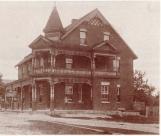 Credits:
Credits:Split Rail Country - A History of Artemesia Volume 1
7
Eugenia was a very busy and prosperous village in the late 1800's, and consequently a fine Victorian style red brick hotel was erected near the main corner. It was operated by Peter Munshaw, a nephew of Aaron Munshaw Jr. of Flesherton. The "Eugenia House" was in use for many years until the death of Mr. Munshaw when it was sold. It has had many owners over the years and was run as a hotel and a rest home.8
Eugenia Hotel1974
Mill Reserve 4, Eugenia, Ontario, Canada
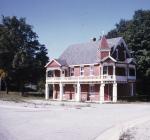 Credits:
Credits:Houses of South East Grey: A Study of History and Architecture
9
The Eugenia Hotel is a large rectangular building of two storeys. Because this was a hote, there are at least 4 entrances - main entrance, back entrance, rooms and bar entrance and the side entrance. A rather unique feature is a small square turret with a tent roof, built into the bottom front corner of the main roof. At the back of the hotel is a small wooden porch, probably the original, that has not withstood the years as well as the remainder of the building.The home is now a private residence and is currently under restoration.
10
Cedarside Baptist Church built 1886early 1900's
37 Sydenham St., Flesherton, Ontario, Canada
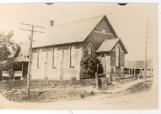 Credits:
Credits:South Grey Museum - Archives
11
The "First Flesherton Baptist Church" was built in 1886 on land purchased from Robert Trimble, a Flesherton merchant, for $60.00. At the corner of Margaret and Sydenham St's., it is situated on the upper bank of the Boyne River in Flesherton and surrounded by cedar trees, thus explaining the change of name for the chapel to "Cedarside Baptist Chapel". It was built by volunteer labour which allowed the cost to be kept low. Electricity was installed in the early 1900's and a furnace in 1958. A parsonage was attached to the east and rear of the chapel (date unknown). In 1888 there were 37 members which grew to 124 members in 1963 when the church was closed and the congregation purchased and relocated to the former Chalmer's Presbyterian Church on Collingwood St. Flesherton, Ontario.12
Cedarside Baptist Church6 January 2011
37 Sydenham St., Flesherton, Ontario, Canada
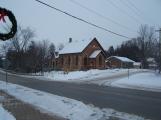 Credits:
Credits:South Grey Museum Collection
13
After Cedarside Baptist Church congregationmoved from this site to take over the former Presbyterian Church on Collingwood St., Flesherton, the church was decommissioned and became a private residence.14
R.J. Sproule BlockCirca 1905
NE Corner Collingwood St. and Sydenham St. Flesherton, Ontario, Canada
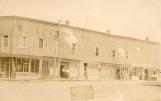 Credits:
Credits:South Grey Museum Collection